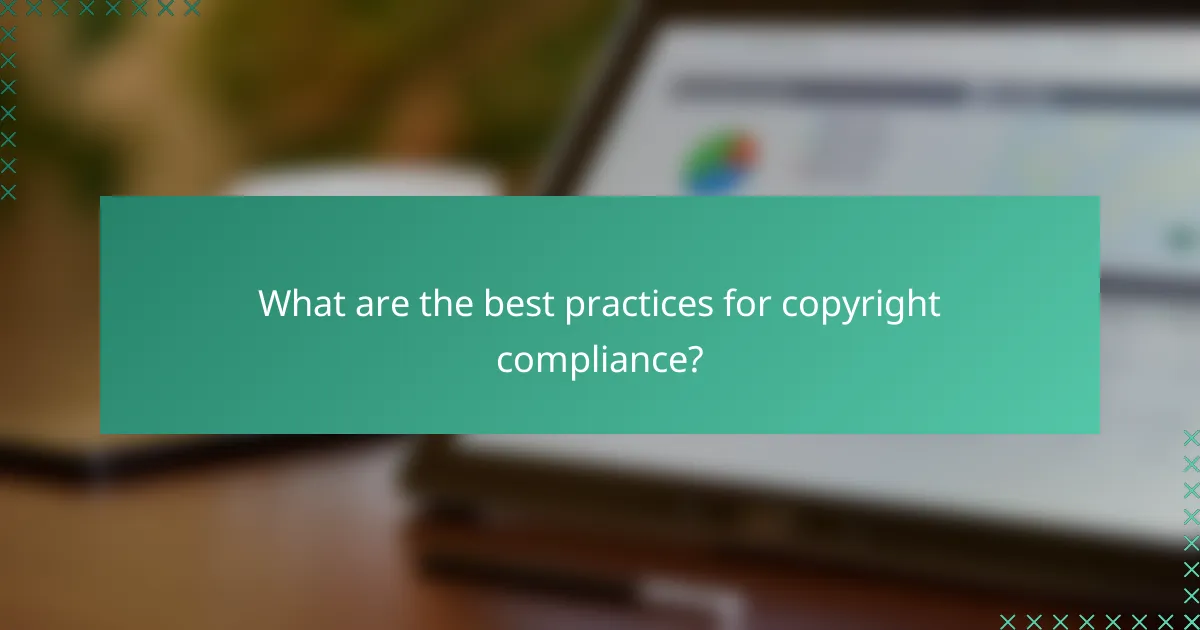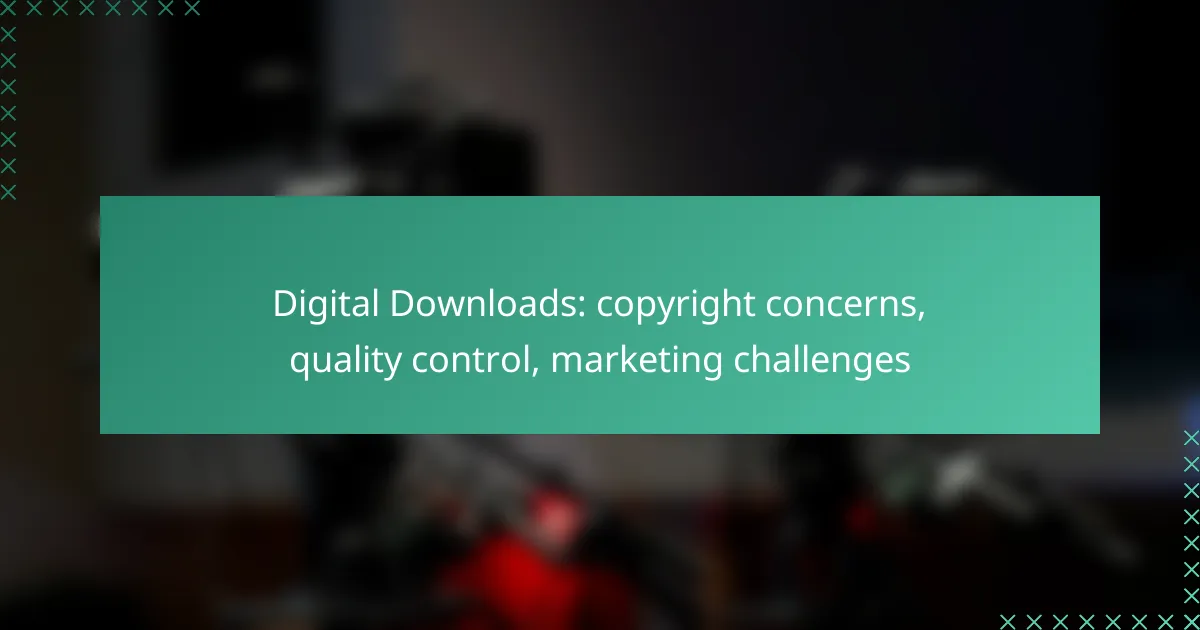Digital downloads present unique challenges, particularly concerning copyright issues, quality control, and marketing strategies. Creators must protect their intellectual property while ensuring their products meet high standards to satisfy users. Additionally, in a competitive marketplace, establishing brand recognition is essential for success and visibility among countless offerings.

What are the copyright concerns for digital downloads in Canada?
In Canada, copyright concerns for digital downloads revolve around the protection of intellectual property rights and the potential for infringement. Creators must navigate laws that safeguard their works while also understanding the implications of sharing and distributing digital content.
Understanding copyright laws
Copyright laws in Canada grant creators exclusive rights to their original works, including digital downloads. This means that authors, musicians, and artists can control how their content is reproduced, distributed, and displayed. The Copyright Act outlines these rights and provides a framework for protecting creative works.
Digital downloads are covered under copyright, meaning unauthorized copying or distribution can lead to legal repercussions. Creators should register their works to enhance protection, although copyright exists automatically upon creation.
Common copyright infringements
Common infringements related to digital downloads include unauthorized sharing, downloading pirated content, and using copyrighted material without permission. For instance, distributing a music album without the artist’s consent is a clear violation of copyright laws.
Many users unknowingly infringe copyright by using digital downloads from unverified sources. It is crucial for consumers to verify the legitimacy of the content they download to avoid potential legal issues.
Fair use exceptions
In Canada, fair use exceptions allow limited use of copyrighted material without permission under specific circumstances. These exceptions typically apply to educational purposes, criticism, or commentary, but the use must be reasonable and not affect the market value of the original work.
For example, a teacher may use a short excerpt from a book in a classroom setting without infringing copyright. However, the boundaries of fair use can be complex, so creators and users should carefully evaluate their specific situations to avoid potential violations.

How can digital product creators ensure quality control?
Digital product creators can ensure quality control by implementing systematic processes and utilizing effective tools to test their products before release. This approach minimizes errors and enhances user satisfaction, which is crucial for maintaining a strong reputation in the digital marketplace.
Quality assurance processes
Establishing a robust quality assurance (QA) process involves several key steps. First, define clear quality standards that align with customer expectations and industry benchmarks. Next, conduct regular reviews and audits throughout the development cycle to identify and rectify issues early.
Incorporating user feedback is essential. Engage a small group of users to test the product in real-world scenarios, gathering insights that can inform necessary adjustments. This iterative process helps ensure that the final product meets quality standards and user needs.
Tools for quality testing
Utilizing the right tools can significantly enhance the quality testing process. Automated testing software can quickly identify bugs and performance issues, allowing for faster iterations. Popular tools include Selenium for web applications and TestFlight for mobile apps.
Additionally, consider using performance monitoring tools like Google PageSpeed Insights or GTmetrix to assess loading times and responsiveness. Regularly analyzing these metrics can help maintain optimal performance and improve user experience.

What marketing challenges do digital downloads face?
Digital downloads encounter several marketing challenges, including the need to establish brand recognition and navigate a crowded marketplace. As more creators and companies enter the digital space, standing out becomes increasingly difficult.
Building brand awareness
Establishing brand awareness is crucial for digital downloads. Creators should focus on creating a strong online presence through social media, content marketing, and collaborations with influencers. Engaging storytelling and consistent branding can help capture the target audience’s attention.
Utilizing platforms like Instagram, TikTok, or YouTube can enhance visibility. Regularly sharing updates, behind-the-scenes content, and user-generated reviews can foster a community around the brand, making it more relatable and trustworthy.
Overcoming market saturation
Market saturation poses a significant challenge for digital downloads, as countless options are available to consumers. To differentiate their products, creators should emphasize unique features, quality, or niche targeting. Highlighting what sets their downloads apart can attract more customers.
Offering limited-time promotions or exclusive content can create urgency and encourage purchases. Additionally, gathering and showcasing customer testimonials can enhance credibility, helping to sway potential buyers in a competitive environment.

What are the best practices for copyright compliance?
To ensure copyright compliance in digital downloads, creators should understand licensing agreements, attribution requirements, and the importance of respecting intellectual property rights. Following these best practices helps avoid legal issues and promotes fair use of content.
Licensing agreements
Licensing agreements define the terms under which digital content can be used, distributed, or modified. When creating or using digital downloads, it is crucial to review the specific licensing terms to understand what is permitted and what is not.
Common types of licenses include exclusive, non-exclusive, and open-source licenses. For instance, an exclusive license grants one party the sole rights to use the content, while a non-exclusive license allows multiple parties to use it. Open-source licenses typically permit free use and modification, provided that attribution is given.
Always keep a record of licensing agreements and ensure that all parties involved are aware of their rights and responsibilities to prevent misunderstandings.
Attribution requirements
Attribution requirements dictate how creators must credit the original authors of digital content. Proper attribution not only respects the creator’s rights but also enhances the credibility of the work being presented.
Different licenses have varying attribution requirements. For example, Creative Commons licenses often require that the original creator’s name, the title of the work, and a link to the license be included when sharing or modifying the content. Failing to provide proper attribution can lead to copyright infringement claims.
To ensure compliance, always check the specific attribution guidelines associated with the content you are using and include all necessary information in a visible location, such as a credits section or footer.

How to implement effective quality control measures?
Effective quality control measures for digital downloads involve systematic processes to ensure that products meet established standards before release. This includes gathering customer feedback, making regular updates, and revising content based on performance and user experience.
Feedback loops with customers
Creating feedback loops with customers is crucial for maintaining quality in digital downloads. Encourage users to share their experiences through surveys, reviews, or direct communication. This feedback can highlight areas for improvement and help identify common issues.
Implementing a structured approach to collect and analyze feedback can enhance product quality. For instance, consider using tools like Net Promoter Score (NPS) or customer satisfaction surveys to gauge user sentiment regularly.
Regular updates and revisions
Regular updates and revisions are essential to keep digital downloads relevant and high-quality. Schedule periodic reviews of your content to ensure it aligns with current standards and user expectations. This could involve updating software, refreshing graphics, or revising text for clarity.
Establish a timeline for updates, such as quarterly or bi-annually, depending on the nature of your digital product. This proactive approach helps prevent obsolescence and maintains user engagement. Always communicate these updates to your customers to reinforce trust and satisfaction.

What strategies can improve marketing for digital downloads?
Effective marketing strategies for digital downloads focus on enhancing visibility and engagement. Utilizing social media and implementing search engine optimization (SEO) techniques are key methods to attract and retain customers.
Utilizing social media platforms
Social media platforms are powerful tools for marketing digital downloads. Creating engaging content, such as promotional videos or user testimonials, can help capture attention and drive traffic to your download site. Regularly posting updates and interacting with followers fosters a community around your brand.
Consider using targeted ads on platforms like Facebook and Instagram, where you can specify demographics and interests to reach potential customers effectively. Offering exclusive discounts or early access to new downloads can also incentivize shares and increase your reach.
Search engine optimization techniques
Search engine optimization (SEO) is crucial for improving the visibility of your digital downloads in search results. Start by researching relevant keywords that potential customers might use to find your products. Incorporate these keywords naturally into your website content, product descriptions, and blog posts to enhance search rankings.
Additionally, ensure your website is mobile-friendly and loads quickly, as these factors significantly impact user experience and SEO performance. Regularly updating your content and obtaining backlinks from reputable sites can further improve your search engine standing, leading to increased traffic and sales.

What are the emerging trends in digital downloads?
Emerging trends in digital downloads include the rise of subscription models, enhanced quality control measures, and innovative marketing strategies. These trends reflect changing consumer preferences and technological advancements, shaping how digital products are distributed and consumed.
Growth of subscription models
The growth of subscription models has transformed the landscape of digital downloads, allowing consumers to access a wide range of content for a recurring fee. This model is particularly popular in sectors like music, software, and gaming, where users prefer flexibility over ownership.
Subscription services often provide users with a vast library of content, which can lead to increased customer retention. For instance, platforms like Spotify and Adobe Creative Cloud offer tiered pricing, allowing users to select plans that fit their needs and budgets, typically ranging from $10 to $50 per month.
When considering a subscription model, businesses should evaluate their target audience’s willingness to pay and the perceived value of continuous access versus one-time purchases. Offering free trials or introductory pricing can be effective strategies to attract new subscribers.
